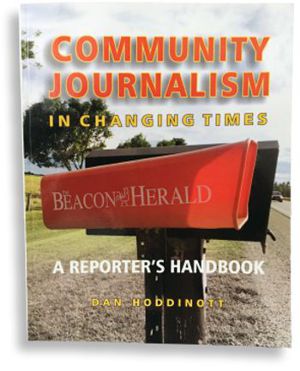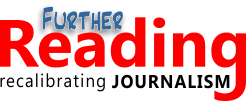Monetizing our digital editions
Thoughts on retrieving the ball we'd dropped in panic
By DAN HODDINOTT
There are no simplistic answers. Moving from a place where our fortunes lived and died on the strength of the print edition to a destination where existence depends very much on our ability to command fair value for digital advertising products is a journey fraught with complexities. The transition from print to digital has not been a smooth ride for the bottom line, in large part because advertising valuations have not proven laterally transferable. Viewed objectively, this is a simple but bewildering fact, given the demonstrable ability of digital ads to outperform their print counterparts in terms of punch and functionality. Looking back at behaviours and attitudes toward Internet fare across the board in the early years, however, how we arrived at this place of instability should be no mystery at all. So how, then, do we get ourselves out of it?
IF THERE EVER WAS A TIME FOR HAND-WRINGING it is now. For at the root of our inability to command equal or greater value for the exponentially more powerful advertising product we market today lies a destructive message our own sales forces were drumming in the market square at the dawn of the digital age: web ads (read: digital instruments) are a cheaply produced, inferior facsimile of the “real” ads we sell. Agents themselves regarded online ads as little more than pot-sweetening throw-ins. And at the root of that gross misperception was an equally gross misapplication of perceived wisdom particular to the sale of widgets on a global scale via the fledgling worldwide web. Though far removed from any chartable connection between the two sales realities, our outlook nonetheless aligned itself with generic Internet projections instead of with real-value targets such as one-for-one peerage between the size of readership we could deliver online compared to what we did in print. As a consequence, valuation of online/digital advertising became tied to ridiculous exponents of the number of eyeballs our websites could attract.
In hockey parlance, the publishing world had forfeited the game in the first period.
At the hometown community newspaper level, we lost sight of what, exactly, we had been selling to our advertisers for as long as we’d been in business: prominence and presence in the marketplace we shared with them, as measured by the number of column inches the advertiser purchased and the number of potential eyeballs the newspaper would be delivering by virtue of its known circulation data. But while considering fair value for online-cum-digital advertising we somehow lost our heads in the scramble to satisfy criteria that simply didn’t apply to us, first of all, and then lost our way in accepting the fallacious logic that any online advertising products were valueless without website hits comparable to those garnered by the New York Times, The Wall Street Journal or the Sunday Times in London.
Seeds of our own destruction
It is from this stance that came the message we crafted and sold, in defending our print edition territory against digital encroachment. Who could foresee that the pervasiveness and sheer usefulness of emerging forms of digital publishing would conspire to, collectively, swamp the higher-price and less-adaptable print product? The market bought into what we were selling: our own doom.
For many newspapers and magazines — especially those in the upper ranges of the circulation scale, where liabilities were greater — this destructive valuation model became conventional wisdom, and said wisdom delivered death sentences indiscriminately as it solidified. While death would come more slowly to hometown newspapers with circulations in, say, the 6,000 – 25,000 range, a general despair set in across the industry once it became clear that everyone would be measuring by the artificial millions-of-eyeballs standard, greatly devaluing web and digital advertising everywhere.
Admittedly, the first period of our proverbial hockey game was rough, but we might have gathered ourselves and refocused in the first intermission had we not chosen instead to wave the white towel between periods. After all, the maximum number of online eyeballs community newspapers like the Northern Pen in St. Anthony or the Prairie Post in Swift Current could reasonably expect to attract would compare to the print circulation numbers true for their own markets, not to the whimsical and utterly unrelated forecasting proposed as accurate for global widget sales. The second period might have seen a turnaround in our fortunes had strong messaging been formulated to express such. But our having had a hand in causing advertisers to conclude a digital ad can never be the equal of its print counterpart left us with nowhere to turn when the fullness of time played itself out the way it did. We had outplayed ourselves rather than the opposing team.
This is the simple version, of course. It is wise to note that the struggle is not a simple matter at all, but one rife with complexities. The simple solution is re-education of the marketplace to the true value of our product. But that too is simplistic, in the face of complexities.
From the community newspaper perspective here, today, coveting what is now available to sell as advertising product to local businesses seems like a no-brainer. So does embracing the astonishing publishing power afforded newsrooms by virtue of multiple platforms. Back in the day, however, there was scarcely universal conviction in the durability of the Internet itself, let alone consensus on its suitability as a news-consumption medium, and the dramatic ways in which a dynamic digital advertising product could outdistance a static, two-dimensional display were yet to be revealed. We’re not here because of negligence; we’re here because critical decisions had to made in a now in which we were all looking through a glass darkly, unable to make out this enlightened point in the future where so very much more is taken for granted.
The reality is, however, we are here. And the only axis around which discussions should rotate would be what we can do to fix things, not where to point righteous fingers. A good starting point is to acknowledge that buyers of advertising space are not blind to the added power of the digital form factor at all. They’re just unwilling to pay what it’s worth, and feel morally justified in taking that stance.
Killer product already here
There are many in our midst, for sure, who would like to return to the “good old days” of calculable fair pricing and where a public demand for free stuff that creates downward pressures in the business world were neglible. But going back would be doing no one any favours. The digital age has done us no wrong, let’s be clear. It has changed the way we go about our affairs, but not to the detriment of anything worth saving. Multi-platform publishing is a boon to every aspect of the community newspaper business, from newfound immediacy and scalability in news coverage to personalized connectivity with the readership and dramatic leaps in advertising dynamics. The conversation has to be about how to change the hearts and minds of buyers of advertising space, not a search for shinier objects with which to dazzle. For the killer product we seek is already here.
A digital ad has exponentially more functionality than anything that ever existed in the realm of newspaper publishing before. Not only is it transferable across platforms, but the viewer simply has to click or tap on a linked image/icon to get it to either animate or deliver the user to a new destination, where a whole array of other possibilities are waiting to unfold. Print ads, by contrast, are passive visual stills, an inanimate state they can never escape. Even those first-generation web ads were one-click wonders and were, like the print ads they mimicked, totally reliant upon the viewer to, first of all, adequately interpret a singular message and then be willing to change location and engage other equipment (say, a telephone or a computer/printer combination) to carry out any suggested actions.
A large percentage of our readership — perhaps the majority already — now consumes our products on digital devices or via the website instead of by the traditional print edition. (It is a good thing to know those percentages and how they break down across platforms.) Perhaps we should acknowledge the trend instead of admitting it, lamenting it or apologizing for it; there is gain to be had in seizing ownership of a new reality and acting as though we’re responsible for it. This way, we can realize the benefits of what is there instead of wasting currency in bemoaning what is no longer there.
The freed mind can then pose important questions such as: What type of advertising message do consumers of digital content respond to? What does prominence look like in an environment where readers are thumbing and swiping through stories instead of turning pages? Or when they’re clicking? How can an ad be cost-effectively repurposed so that it appears native to consuming habits on several platforms, including print?
Just like the newsroom, the advertising department is challenged with recognizing what percentage of the readership is consuming content on what specific platforms and devising strategies to help them connect at every there they identify. And just as the newsroom is preoccupied with ensuring the newspaper remains relevant in the community, good advertising pitches would intimate just how preoccupied the newspaper’s advertising department is with ensuring the Main Street business remains relevant among the local readership — and is not left behind.


